Hibiscus are sun-loving, flowering plants that enjoy warm temperatures. However, gardeners that wish to have them indoors keep wondering whether Hibiscus will respond well inside. The first thing that strikes them is whether it is an indoor plant or an outdoor plant.
Hibiscus can grow both indoors and outdoors if it gets the right care. Tropical Hibiscus is sometimes grown indoors in cold regions because they are frost-tender, but they can grow outdoors in zones 9-11. Hardy Hibiscus can grow indoors and outdoors in zones 4-8.
You can grow Hibiscus wherever you wish. But, you only need to take care of their requirements and check them daily to observe their reaction.
Today I will share whether Hibiscus will survive indoors or outdoors and how to take care of them accordingly.
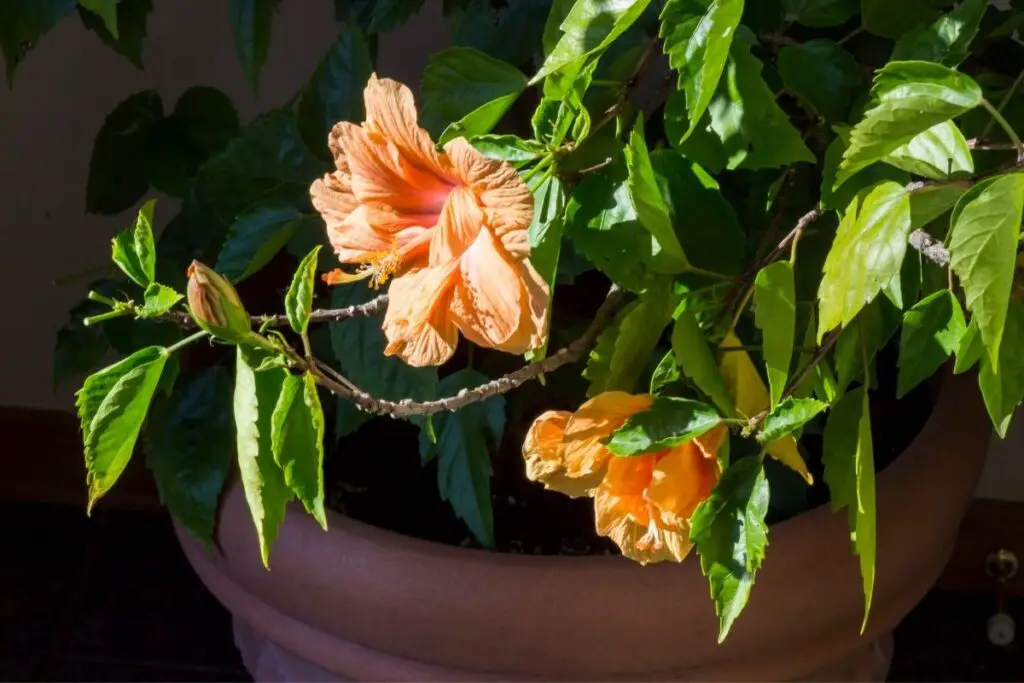
Is Hibiscus an indoor plant or an outdoor plant?
You can grow Hibiscus plants indoors and outdoors if you provide them with all their requirements.
If you want to grow a Hibiscus outdoors, train the shrub species to become a plant.
Cut some branches and leave a strong one to grow as a central trunk.
Though Hibiscus are mostly grown as outdoor plants, many gardeners grow them indoors.
Tropical Hibiscus plants cannot tolerate cold winters.
So, if you belong to regions with low temperatures in winters, grow them indoors.
You can still grow Tropical Hibiscus outdoors.
Just bring them indoors when the weather drops below 50°F.
You can also keep them outdoors the whole year if you belong to zone 9-11.
What are the general requirements of Hibiscus plants?
By getting familiar with the basic needs of Hibiscus plants, you can understand how to take care of them indoors and outdoors.
Light
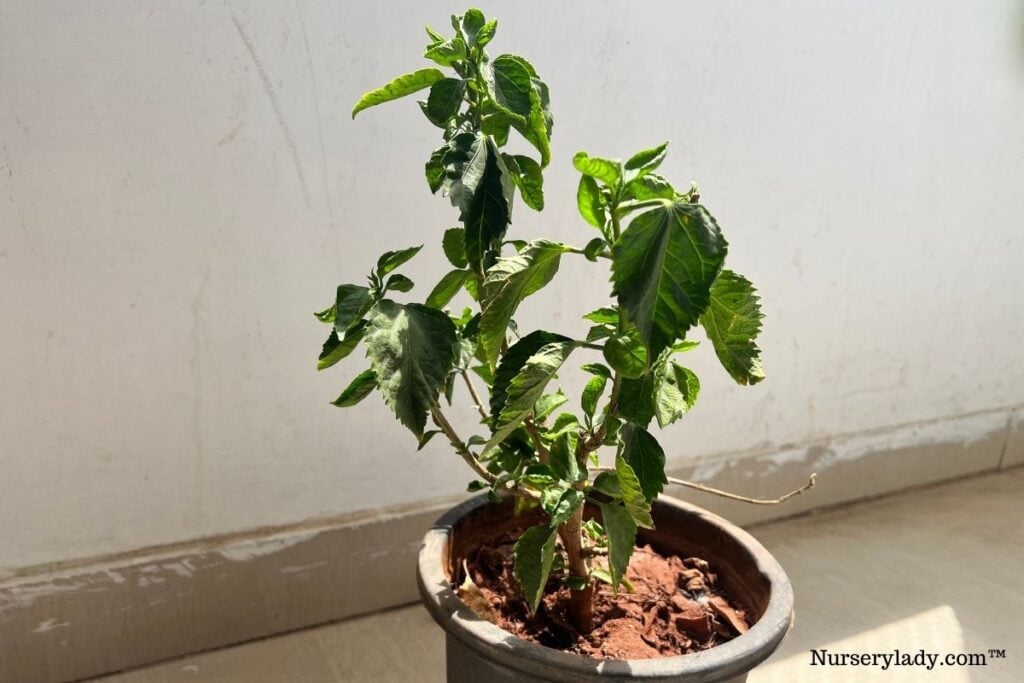
Hibiscus plants enjoy a lot of direct sunlight.
They need at least 4 to 8 hours of sunlight daily.
If the sunlight gets intense in summer, protect them with shade.
Let them have at least 2-3 hours of direct sunlight and then 6-8 hours of filtered sunlight.
This will save them from sunburn.
Try to give them more direct sunlight in winters to maintain a warm temperature.
Also read: How Much Light Does A Hibiscus Plant Need? (What Kind, How Much & More)
Water
Hibiscus generally requires watering 4-5 days per week.
They love to grow over moist soil.
For example, Rose Mallows enjoy growing over marshy soil.
The frequency of watering differs depending on the weather.
Hibiscus will need daily watering in the summers.
Sometimes, they will require it 2-3 times a day if the weather is very scorching.
In the winters, reduce watering.
Once per week would be enough to keep them hydrated.
Always check the soil moisture before watering.
Only water the plant when the top 1-2 inches are dry.
Also read: How To Water Hibiscus Plant? (How Much, How Often & More)
Soil

Hibiscus enjoys well-drained, loamy, and moisture-retentive soil.
The soil must have a balance between drainage and retention.
Along with that, the soil must be rich in nutrients.
Hibiscus plants are heavy feeders, and they need lots of nutrition for better development and flowering.
The soil pH should remain between 6.5 and 6.8.
Hibiscus can tolerate neutral to slightly acidic soil but not alkaline.
Also read: What Kind Of Soil Does A Hibiscus Plant Like? (+Best Soil Mix)
Fertilization
Hibiscus requires sufficient fertilization for fast and healthy growth and big colorful blooms.
If you are using liquid fertilizers, apply them every 2 weeks in the spring and summer and every 4 weeks in the autumn and winter.
If you are using slow-release, use it every 3-6 months in the growing months.
Apply it 2-3 times throughout the growing season during new growths. Don’t use this fertilizer in winters.
Also read: What Is A Good Fertilizer For Hibiscus Plants? (Ideal Ratio+Best Pick)
Temperature
Hibiscus likes to grow in temperatures ranging between 60-85°F.
Below 50°F, the plant will stop growing and flowering.
Even if they flower, the blooms will be smaller.
If you are growing tropical Hibiscus, grow them in containers and shift them indoors when the weather begins to cool down in the fall.
The Hardy Hibiscus variety can stay outside.
They are generally native to zones 4-8 and can tolerate temperatures as low as 10-30°F.
If you live in a region where the temperature dips at this range in winters, it is better to grow Hardy Hibiscus.
However, whatever variety you grow, you have to protect them in winters.
Humidity
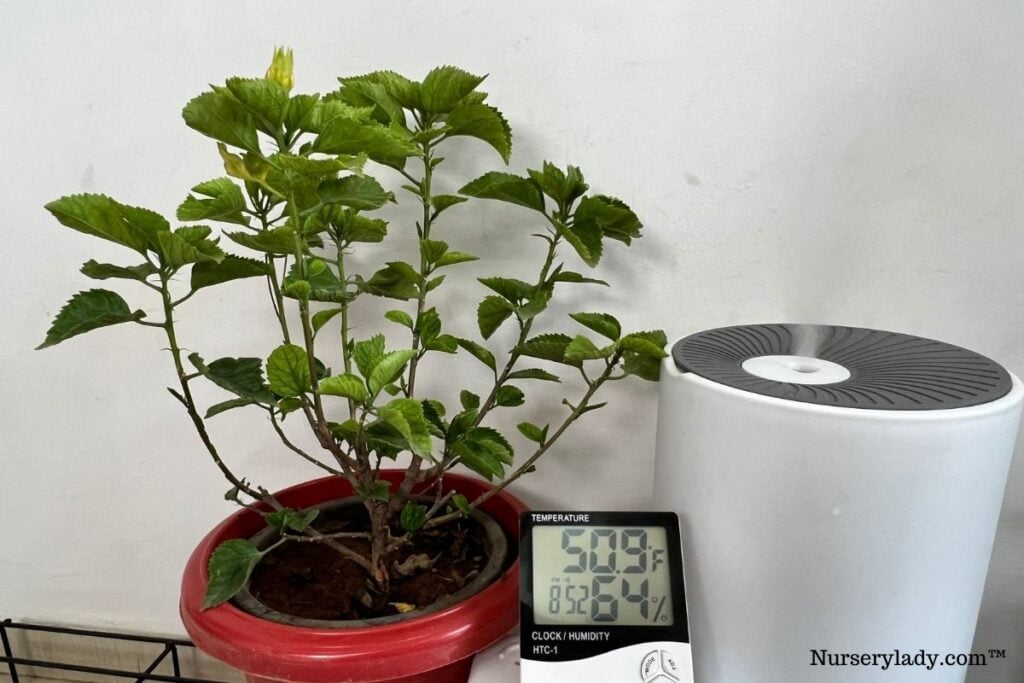
Belonging to the tropical regions, Hibiscus enjoys high humidity.
It should be within 50-70%.
Hibiscus stays in humidity levels around 90% in some greenhouses, but don’t try this at home.
Greenhouse plants remain under special care that you won’t be able to provide to the plant.
So, maintain at least 60-70%.
Make sure it doesn’t go below 50%.
Otherwise, the plant will drop flower buds.
Also read: Do Hibiscus Like To Be Misted? (+Humidity Requirements)
Looking for gardening supplies? We have tested 100's of products before recommending them to you guys. Check out our best pick below:
| Image | Gardening Supplies | Best Price? |
|---|---|---|
 Top
Top Top
Top | Raised Garden Bed Kit | Check On Amazon |
 | XLUX Soil Moisture Meter, Plant Water Monitor, Soil Hygrometer Sensor for Gardening, Farming, Indoor and Outdoor Plants, No Batteries Required | No Results |
 Top
Top Top
Top | 82 Pcs Garden Tools Set and Extra Succulent Tools Set | Check On Amazon |
 | Joeys Garden Expandable Garden Hose with 8 Function Hose Nozzle, Lightweight Anti-Kink Flexible Garden Hoses, Extra Strength Fabric with Double Latex Core, (50 FT, Black) | No Results |
 Top
Top Top
Top | Dual Chamber Compost Tumbler | Check On Amazon |
 Top
Top Top
Top | Sunnyglade Plant Stakes | Check On Amazon |
 Top
Top Top
Top | Organic Cold Pressed Neem Seed Oil | Check On Amazon |
 Top
Top Top
Top | Mighty Mint Gallon :-Insect and Pest Control Peppermint Oil | Check On Amazon |
 Top
Top Top
Top | Scotts DiseaseEx Lawn Fungicide | Check On Amazon |
 Top
Top Top
Top | Jacks Classic 20-20-20 All Purpose Fertilizer | Check On Amazon |
 Top
Top Top
Top | 30,000 Seeds Pollinator Attracting Wildflower Mixture | Check On Amazon |
 Top
Top Top
Top | Survival Vegetable Seeds Garden Kit-Over 16,000 Seeds | Check On Amazon |
Container
Make sure you use a container with drainage holes for good drainage.
The size of the container should depend on the plant’s size.
Don’t use the same pot for a long time.
As the plant grows larger, it will need space to grow.
So, change the container accordingly in time.
Don’t use a big container as that can cause overwatering.
Terracottas are best because they are porous.
If you ever overwater by mistake, the pot can wick away moisture and increase air circulation.
It also helps to release the hot air and prevent your plant from getting overheated.
However, you can use any type you like, plastic, ceramics, wooden, etc.
Also read: What Kind Of Pot Is Best For Hibiscus? (Size, Material & More)
Repotting
Repot the potted Hibiscus every year. Hibiscus is a fast-growing plant.
Within a few years, they can reach 10-12 feet.
Repotting gives more space to grow and prevents root-bound.
- While repotting, use a container 1-2 inches bigger than the old one.
- Cut off 1/3rd portion of the roots if you don’t want the plant to grow big, including the damaged and broken ones.
- Plant them in the same size as the old container.
- But to encourage growth, cut off only the broken and diseased roots and plant them in a big-sized container.
- After repotting, don’t expose your plant to direct sunlight.
Let them recover from the transplant shock and get settled.
Then you can let them have enough sunlight.
Also read: Should Hibiscus Be Root Bound? (+When To Repot)
Pruning and deadheading
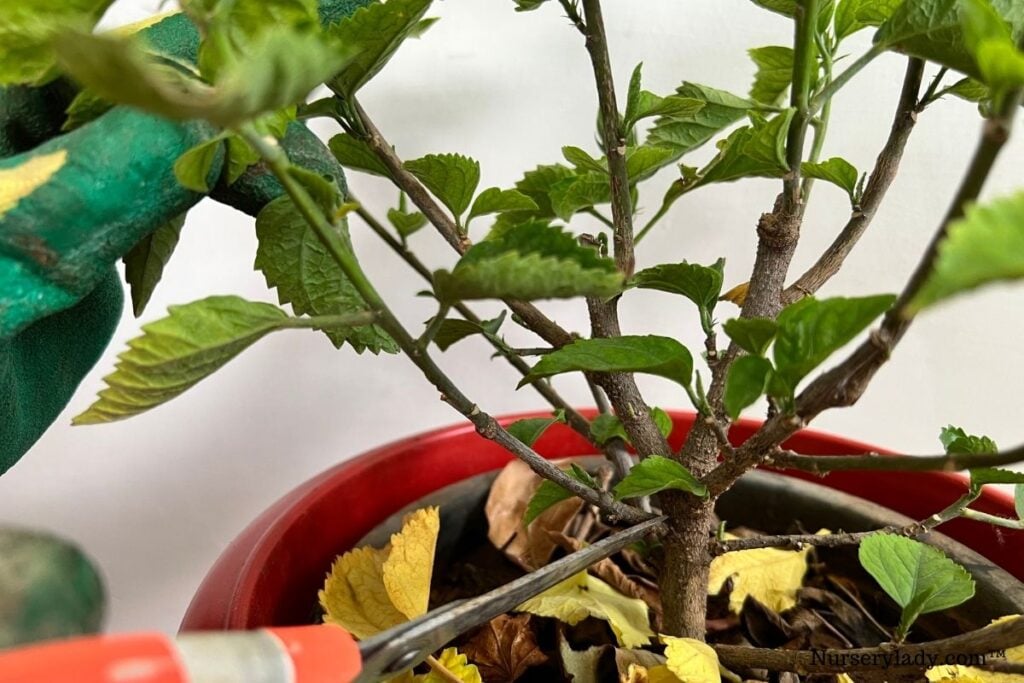
Prune the Hibiscus to keep them healthy and in shape and promote flowering.
For pruning perennial Hibiscus, wait until the late winter or early spring.
Prune off only the old growths because trimming new growth will affect flowering.
Either they won’t bloom or bloom later in the fall, after which they will all die.
Prune off down to 6 inches above the ground.
Keep the stems in the same size.
Prune the Tropical Hibiscus any time in their growing months.
Remove the dead branches and maintain a good shape.
You can also do it at the end of the growing season.
Remember not to prune off heavily.
Only 1/3rd will be trimmed at a time.
If you are bringing an outdoor plant indoors in winters, prune them if only you have kept them in a sunny and warm environment.
Avoid if the environment is cool and dark.
Dividing
Divide the Hibiscus if it has grown too big.
It is necessary because the plant’s rootball won’t be able to provide enough nutrients to every part of the plant.
So, you need to divide the plant and transplant it to a new place or pot.
It will encourage healthy growth, and both parts of the plant will receive enough nutrients.
Over time, they will become full-grown plants.
Note: These are the general care tips for Hibiscus and are applicable for both indoor and outdoor plants.
How to grow Hibiscus outdoors?
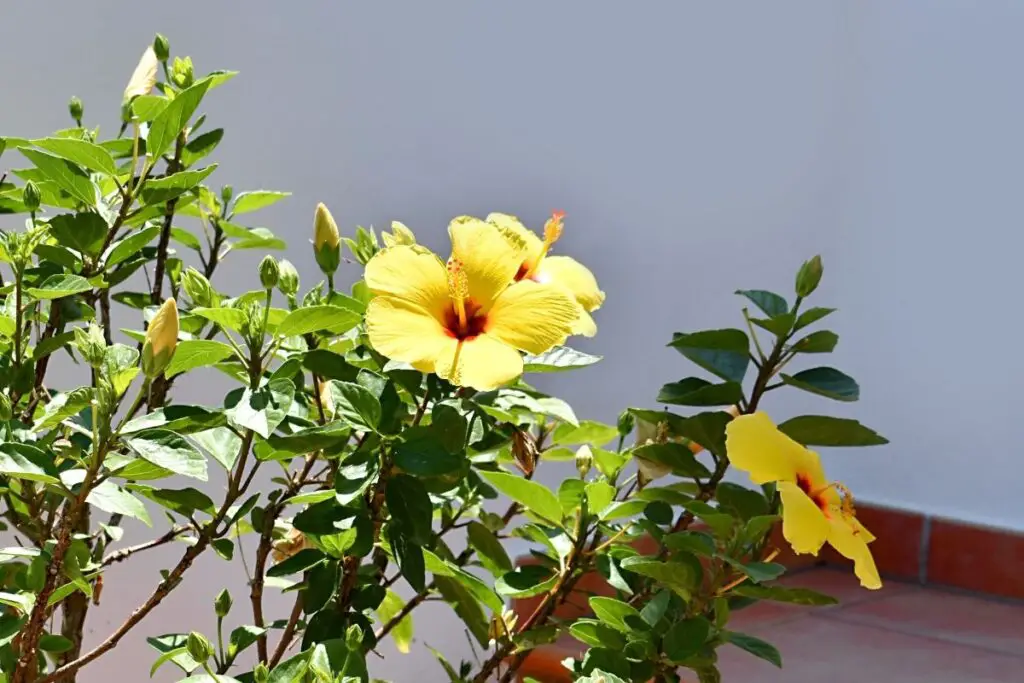
Follow these care tips for the outdoor Hibiscus plants.
Plant in the right location
For growing Hibiscus outdoors, the location is important.
It will determine how much amount of light the plant will receive.
Select the sunniest spot in your garden.
It is generally in the southern or western direction but will differ depending on the hemispheres.
It would be good if there were some tall trees at a distance.
They can give the planting site some shadow which is helpful during the scorching summers.
So, if your garden has such a location, plant your Hibiscus there.
Water the plant deeply
Since they are outdoors under the sun, they will require more watering.
Generally, they need 4-5 times watering per week, but they will need daily watering in summers.
If the weather is too sweltering, Hibiscus will need 2-3 times watering per day, both grounded and potted plants.
Consider deep watering.
In the winters, they go dormant and won’t take that much water.
However, since the weather is dry during the winters, the moisture can evaporate quickly.
In that case, you have to water them.
It is always better to check the moisture level before watering.
Provide water only if the top 1-2 inches of the soil is dry.
Amend the soil bed
Don’t directly plant the Hibiscus plant over any kind of soil bed.
Check the drainage first. If the soil bed is too clayey or sandy, you need to add ingredients to amend the soil.
If the soil is too clayey, add sand, gypsum, perlite, or pumice to improve drainage.
In the case of sandy soil, add coco coir, compost, volcanic rocks, or other organic matters for retention.
Perlite also helps to improve retention.
Adding compost as mulch increases the quality of the soil and makes it nutritious for the Hibiscus plants.
Ensure the pH level of the soil.
Use lime to increase the pH level of the soil.
To decrease it, use peat moss or sulfur.
Check the permeability
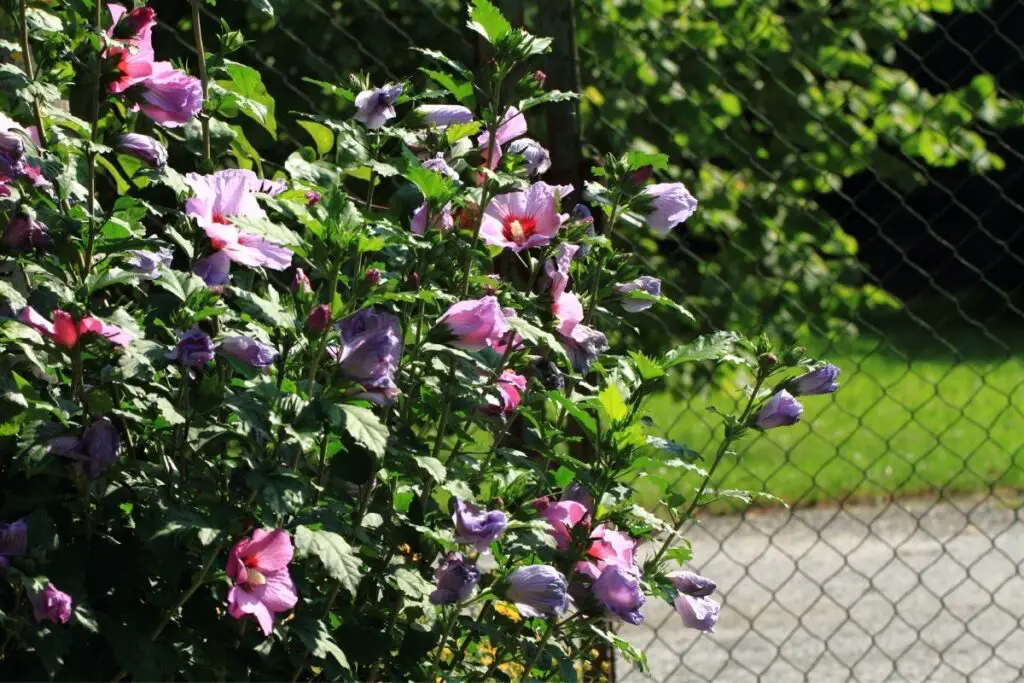
While growing Hibiscus outdoors in the ground, checking how deep the water can penetrate the soil is essential.
Hibiscus roots can grow around 6 inches deep.
So, you need to see whether the water you provide can reach that deep or not.
Otherwise, the plant will suffer from dehydration.
As they remain under the sun, the soil will dry out faster.
The plant won’t remain strong if the water doesn’t reach the roots properly.
Spacing
Hibiscus grows wider and not taller.
Keep enough space between each plant if you are growing many of them.
Hibiscus can spread around 2-3 feet.
So, maintain a distance of 3-6 feet.
This will give them enough space to grow and even maintain good airflow, which is another minor yet important factor.
Keep at least 2-3 feet of space between each plant if you are planting Hibiscus for a hedge or screening.
Planting time
Since Hibiscus plants are sun-lovers, plant them when the winter has ended.
Wait for the temperatures to warm up.
Plant them at the same depth as the roots.
Their growing months are spring and summer.
Once the heat goes up, the plant will begin to grow vigorously and even produce blooms in the very first year.
Temperature and humidity
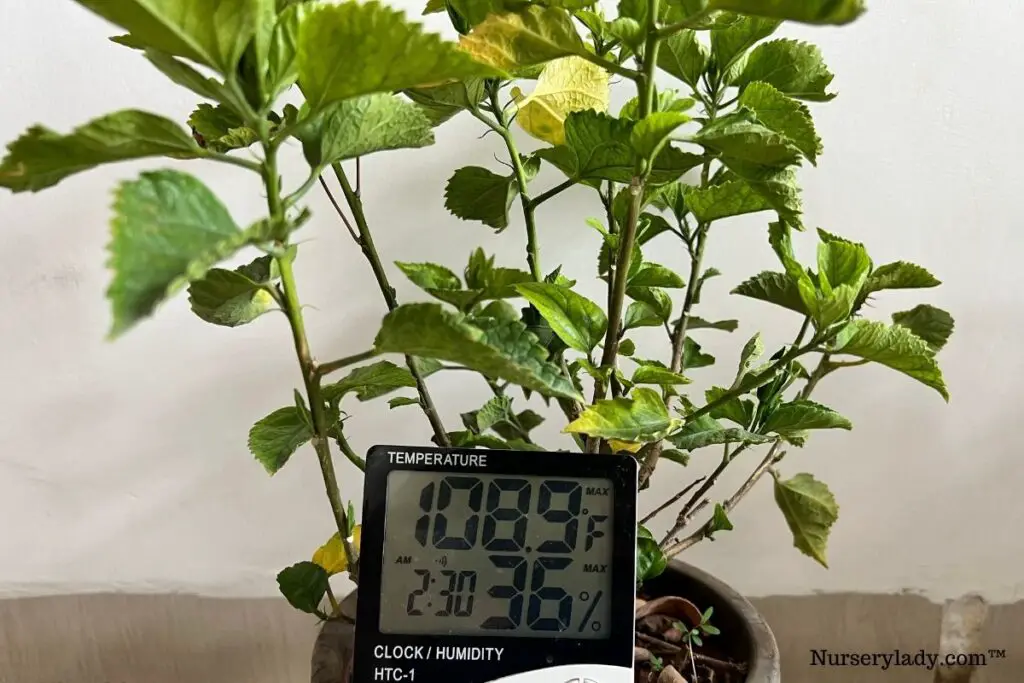
You cannot control the temperature and humidity outside.
If you want to grow Hibiscus outdoors, make sure the temperature remains warm, around 60-75°F during planting.
During the winters, bring Tropical Hibiscus indoors as they are frost-tender plants.
You can keep Tropical Hibiscus outdoors if your region receives temperatures above 50-55°F.
You don’t have to worry about Hardy Hibiscus.
You can grow them outdoors and even keep them outdoors in winters.
Increase the humidity for the outdoor plants if the natural humidity is insufficient.
It is required mainly during the winters.
For increasing humidity:
- Mist your plants, or install a misting system
- Keep water trays around the plant
- Group planting
- The tall trees around can trap the moisture and prevent it from escaping.
- Add mulch to the plant’s base.
Rejuvenate the soil
Revitalize the soil every year like repotting.
Excessive old and compact soil can restrict the roots from spreading and make them root-bound.
Renew the soil by tilting the site, removing the debris, and adding organic matter.
It will improve the soil quality, allow the roots to grow and spread flexibly and give the plant more nutrition.
Bring outdoor Tropical Hibiscus indoors
If you live in a cold region and growing Tropical Hibiscus, grow them in containers and bring them indoors to save them from frost damage.
Since they are tender, frost can damage and kill them.
How to take care of Hibiscus indoors?
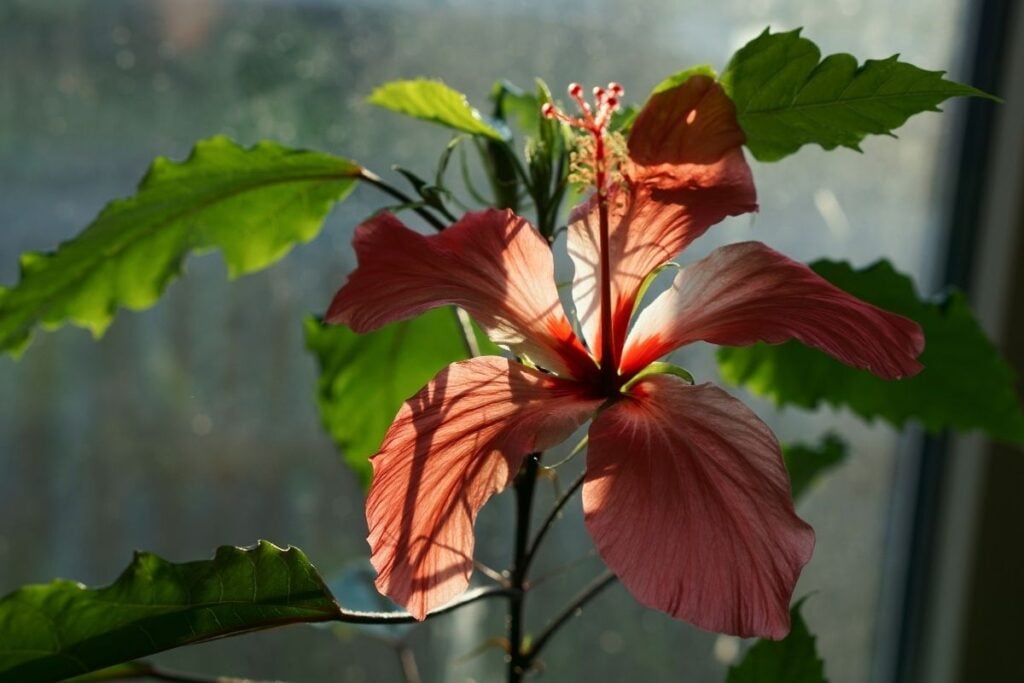
Here are some care tips to take care of indoor Hibiscus plants:
Find a sunny window
Indoor plants might suffer a little bit for light.
They won’t receive direct sunlight as the outdoor plants do.
That is why there might be rare chances of blooming.
However, the plant will still stay alive. For healthy blooming plants, place them near the south or west-facing window.
If they are not getting direct sunlight for 6-8 hours, let them have 2-3 hours of direct sunlight daily and filtered sunlight for the rest of the day.
You can also use artificial lights.
Take them outdoors
You can shift Hibiscus outdoors in summer.
It will encourage the plant to produce prolific blooms.
But, a transition is necessary.
Begin exposing them for 1-2 hours and slowly increase the timing in the next 1-2 weeks.
You can also shift them outside in winters during the daytime.
It will help them remain warm.
Again take them inside when the weather becomes cold in the evening or windy.
Water them regularly
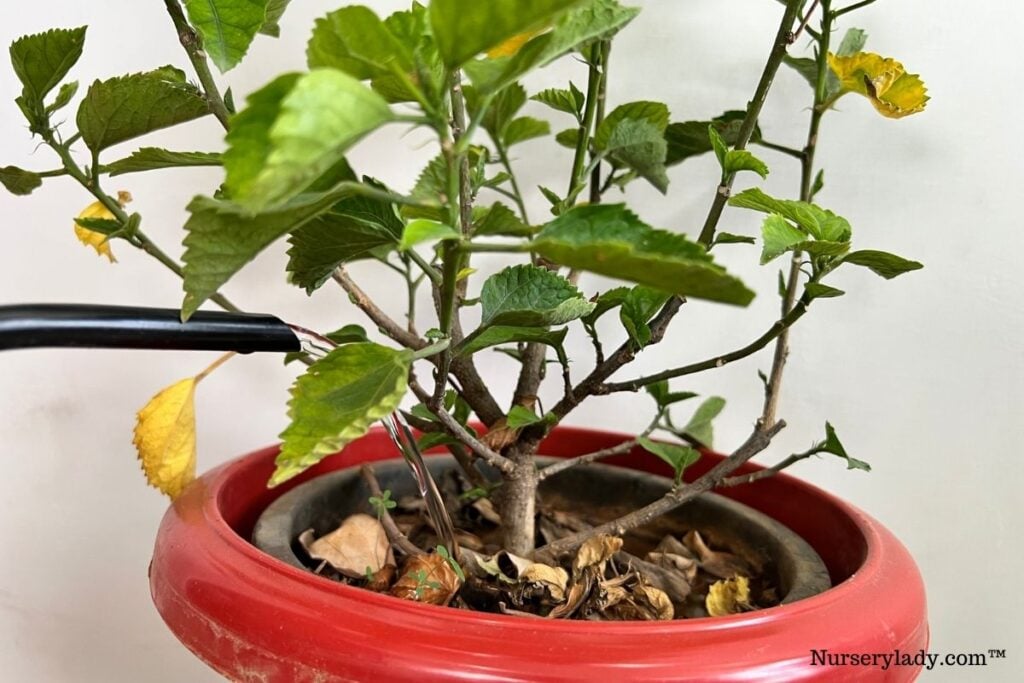
Hibiscus like lots of water, but make sure not to overwater them.
Water the plant when the top 1-2 inches are dry.
In the summers, Hibiscus will need regular watering, sometimes 1-2 times per day, especially if they are receiving direct sunlight.
In the winters, they will become dormant.
However, there is less chance of this because they will remain indoors in a controlled environment.
However, they will need less water compared to spring and summer.
Water the plant deeply until the excess water drains out of the drainage holes.
Soil mix for Hibiscus
Drainage, retention, nutrition, and the right pH level are crucial for Hibiscus plants.
For an ideal soil mix, try the following recommendations:
- 2 parts potting soil, 2 parts peat moss, and 1 part vermiculite or perlite
- 1/3 of each potting soil, compost/worm castings, and peat moss/coco coir
- 50% peat, 45% composted bark, and 5% perlite.
You can use these soil mixes for all potted Hibiscus indoors or outdoors.
Ensure that the pH level stays between 6.5 and 6.8. Hibiscus can survive slightly acidic soil.
(Follow the outdoor soil point to increase and decrease pH level)
Maintain ideal temperature
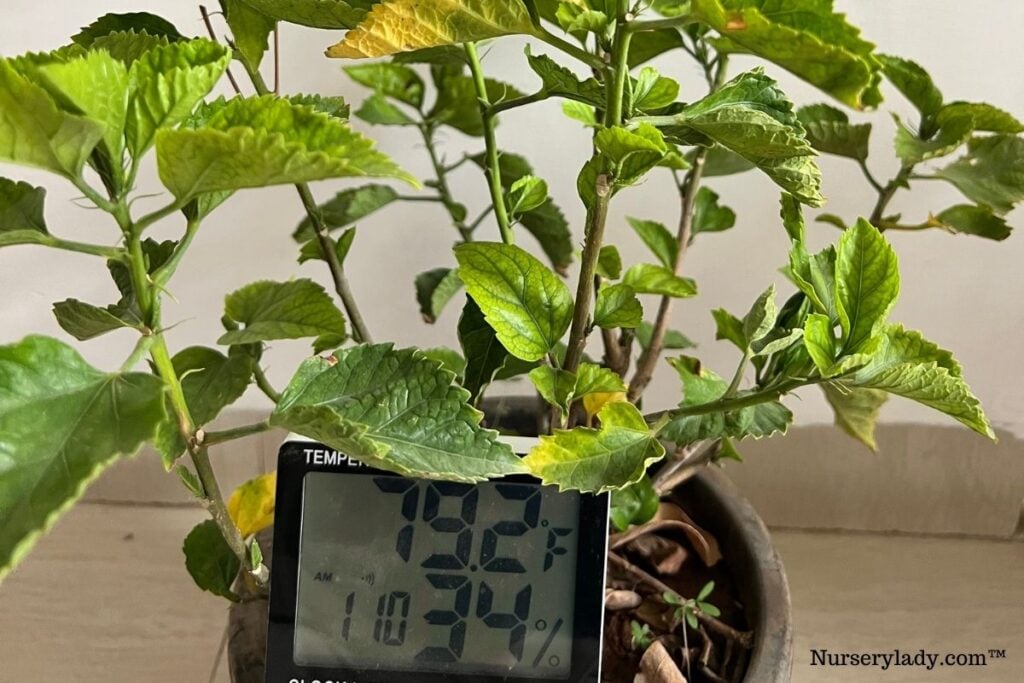
Find a room with temperatures having 60-75°F consistently.
If the plant receives this temperature the whole year, it will grow throughout the year without being dormant.
Avoid AC rooms and areas close to direct fans.
Keep them away from the doors and windows that are frequently opened and closed.
The constant drafts can enter and stress the plant.
Maintain the humidity
Since Hibiscus is from a tropical climate, they will enjoy high humidity levels.
Check the humidity level of your room with a hygrometer.
If it shows below 50%, follow the following steps to increase it:
- Mist the plant
- Use a humidifier
- Keep pebble trays under the pots
- Keep your plant near an aquarium or a bright bathroom
- But, don’t keep them close to furnaces and fireplaces. That will overheat the plant and burn the roots.
Repotting
Repot Hibiscus every year.
This gives the plant more room to grow and saves it from extreme root-bound.
Repotting also gives the chance to replace the old soil with a new one and improve the plant’s health.
Note: Some points like container, fertilization, and detailed repotting are not mentioned in the indoor and outdoor settings because I have included them in the general requirements.
It works the same for both indoor and outdoor plants.
Final thoughts
If taken proper care of, Hibiscus will grow both outdoors and indoors. Some care tips are the same for both the setup and some are distinctive. The essential requirements are sun, water, light, and fertilizer.
These are the same and should be given at the right time at the right frequency. Maintain warm temperature and high humidity around the plant. Repot, replenish the soil, prune and divide to encourage new and healthy growth and blooms.
Reference: Wikipedia, ASPCA, Louisiana State University Agricultural Center, American Society for Horticultural Science, Tropical Hibiscus by Texas A&M University, Sciencedirect.
